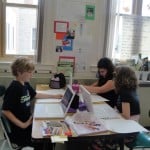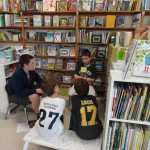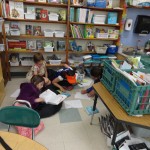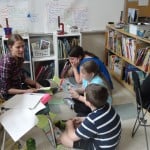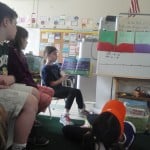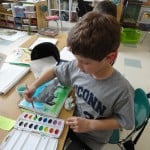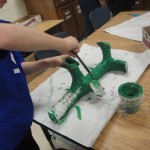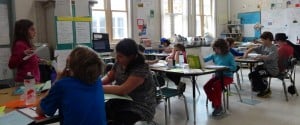 Thank you for all you do to support your children by working on their floats, helping them with homework and celebrating their passions and interests. They are involved and interested in so much They are working, but they are tired. Any things you can do to encourage them to focus on completing the many great projects we have in process – the Wonders books, the class magazine, the habitat models and food chain mobiles – would be greatly appreciated. I know everyone in the class would like everyone to be included in each of these projects. Your encouragement and support are greatly appreciated.
Thank you for all you do to support your children by working on their floats, helping them with homework and celebrating their passions and interests. They are involved and interested in so much They are working, but they are tired. Any things you can do to encourage them to focus on completing the many great projects we have in process – the Wonders books, the class magazine, the habitat models and food chain mobiles – would be greatly appreciated. I know everyone in the class would like everyone to be included in each of these projects. Your encouragement and support are greatly appreciated.
Naturalist Teams At Work
a challenge to cooperate, collaborate and teach others
The children have continued to work in their small groups to learn about four different macro-habitats in our world. They have listed animals and plants. They have listed many of the unique characteristics of their habitat and they are beginning to explore the relationships between the plant and animal life found there. They are working to identify different food chains to understand food webs and ecosystem found in their habitat.
We have learned that all food chains begin with sun and water, and that they end with decomposers or “the clean up crew” as they put it. There is a wide variety of food chains found in each habitat and we hope to discover them while learning about the classifications of plant and animal species.
As a model for this project our class is learning about the rainforest. We are learning through shared readings, paired discussions, writing and drawing. So far we have listened to A Day in the Rainforest by Jean Craighead George and Afternoon on the Amazon by Mary Pope Osborn. We have combined these readings with a few picture books, Sparky, The Great Kapok Tree and Crickwing to add greater understanding about how all species are interrelated. Our next read-aloud resource is the Rain Forest Research Guide. When we feel we have learned enough we will build a model, much like those found in a Natural History Museum, to show and explain why this habitat is important to our world.
This work in the Naturalist Teams requires both academic and social learning. I have been very pleased with the way that the children have allocated jobs in their groups, taken turns with various roles and worked hard to share resources and see that tasks are completed.
New and Continuing Book Clubs
we can’t thank Matt and Sky enough for their time to read with us
This week one of the Humphrey clubs continued and three new book clubs formed. We are excited to be reading in different groups and to be reading such diverse books. Matt’s group is reading Riding Freedom by Pam Munoz Ryan. It is based on the true story of Charlotte Parkhurst, who in 1860, defied the expectations for girls at the time and lived a life that suited her – she loved horses and drove a stage coach. Sky’s group is reading The Music of Dolphins. This story is of a 12 year old girl who has been raised by dolphins. She is found and rehabilitated to a life with people. Winter According to Humphrey is questioning how you work together so everyone feels successful and accomplished. And the last group, Hatchiko Waits is exploring ideas of loyalty and dedication through the true story from Shibuyo in Japan.
The structure of the book clubs and the gift of having Matt and Skyler join our classroom community seems to have convinced many of the children that they capable readers. They are questioning more and becoming thoughtful, wondering readers. They are looking to make sense of things and to understand. I am proud of their efforts to become more thoughtful and more willing to notice that we all think and understand what we are reading differently.
Wrapping Up Wonders Research and Writing
Now that the Parade is a week away the children are beginning to feel the importance of using their time wisely, completing their research and writing about the Wonders. I think a few of them are feeling concerned about what they will have finished to put on display that evening. Several of them have commented that they could do it at home because their mothers would tell them what to write. (Please don’t do that.) This is challenging work but doable. It requires using inferencing skills and finding words to describe the images they have in their minds. Because of the effort required, some of them have resisted it. They have spent time scrolling through images or copying recipes or listening to their state song. I hope we can help them learn from this. They’ve had six weeks to research and write about their wonders. Our goal in this writing project was to learn how organization is important in writing. Some of the children have used this opportunity to develop leads and conclusions for their writing. Some have put them main ideas first and supported them with details they found interesting. They have attempted to add voice to their pieces and truly hope you will be interested in their Wonders.
Bits and Pieces –
- This week, along with our small group work focusing on social relationship and responsibility, we had some great conversations about exclusion and kindness. After reading Crickwing we were impressed by how the leaf-cutter ants, who were teased, did not tease back. They chose to be forgiving and kind. This made everyone in the story feel relieved and happy. Good things happened. We are guessing it could be the same for us.
- We are reviewing the lower case cursive letters and learning how the capitals are formed.
- Wa-hoo! The Parade of the States is coming! The Parade of the States is coming!
